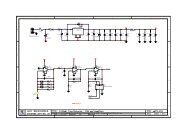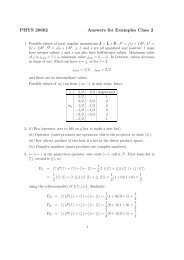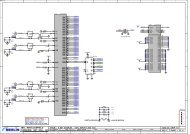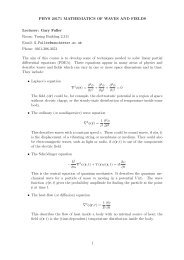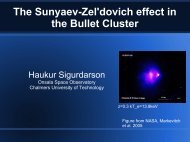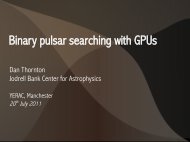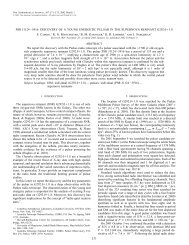High Energy Astrophysics - Jodrell Bank Centre for Astrophysics
High Energy Astrophysics - Jodrell Bank Centre for Astrophysics
High Energy Astrophysics - Jodrell Bank Centre for Astrophysics
Create successful ePaper yourself
Turn your PDF publications into a flip-book with our unique Google optimized e-Paper software.
<strong>High</strong> <strong>Energy</strong> <strong>Astrophysics</strong><br />
Radiation Processes 1/4<br />
Giampaolo Pisano<br />
<strong>Jodrell</strong> <strong>Bank</strong> <strong>Centre</strong> <strong>for</strong> <strong>Astrophysics</strong> - University of Manchester<br />
giampaolo.pisano@manchester.ac.uk - http://www.jb.man.ac.uk/~gp/<br />
February 2012
Radiation Processes<br />
- There are many radiation processes in <strong>Astrophysics</strong>:<br />
- Bremsstrahlung (free-free emission)<br />
- Compton Scattering<br />
- Synchrotron emission<br />
- Absorption processes<br />
- Self-absorption<br />
- Pair production<br />
- Ionisation Losses<br />
- Cherenkov radiation<br />
- Nuclear interactions<br />
Not discussed in this course
Thermal and non-thermal processes<br />
- Thermal processes<br />
- Black-body radiation<br />
- Thermal Bremsstrahlung<br />
- Non-thermal processes<br />
- Non-thermal Bremsstrahlung<br />
- Inverse Compton scattering<br />
- Synchrotron radiation<br />
Continuum radiation from particles with<br />
energy spectrum not Maxwellian
Radiation Processes<br />
- Thermal and non-thermal processes<br />
- Radiation from accelerated charged particles<br />
- Bremsstrahlung (Free-free emission)<br />
- Compton Scattering<br />
- Synchrotron emission<br />
- Absorption processes<br />
- Competing processes<br />
References:<br />
- Rybicki & Lightman - Chapter 1<br />
- Rosswog, Bruggen - Par. 3.7<br />
- Longair - Vol 1, Chapter 3
Radiation from accelerated charged particles 1/6<br />
J.J. Thomson’s treatment : radiation origin in terms of electric field lines<br />
Electric field<br />
lines<br />
(the standard complex derivation uses retarded potentials)<br />
1) Stationary q in inertial frame at t=0<br />
2) Small acceleration to ∆v in ∆t :<br />
const v<br />
3) After t, consider sphere radius r=ct :<br />
q<br />
∆v<br />
c∆t<br />
- Outside sphere:<br />
field lines do not yet know that<br />
charge has moved radial to O<br />
- Inside sphere:<br />
field lines radial in reference<br />
frame of moving charge<br />
∆v
Radiation from accelerated charged particles 2/6<br />
E r Radial component<br />
(Coulomb’s law)<br />
E r<br />
E ϑ Tangential component<br />
E ϑ<br />
ϑ<br />
∆v<br />
Emitted<br />
at t=0<br />
Emitted<br />
after ∆t<br />
r=ct<br />
c∆t<br />
Longair<br />
Par 3.3.2<br />
Watch very nice animation at:<br />
http://www.ligo.caltech.edu/~tdcreigh/Radiation/<br />
Eϑ ∆v<br />
t sinϑ<br />
=<br />
E c∆t<br />
r<br />
→<br />
⎛ ∆v<br />
⎞⎛<br />
t ⎞<br />
Eϑ = Er<br />
⎜ ⎟⎜<br />
⎟sinϑ<br />
⎝ ∆t<br />
⎠⎝<br />
c ⎠
Radiation from accelerated charged particles 3/6<br />
E r Radial component<br />
(Coulomb’s law)<br />
E r<br />
E ϑ<br />
E ϑ Tangential component<br />
( t=r/c )<br />
ϑ<br />
⎛ ∆v<br />
⎞⎛ t ⎞<br />
Eϑ = Er<br />
⎜ ⎟⎜<br />
⎟sinϑ<br />
=<br />
⎝ ∆<br />
t<br />
⎠⎝<br />
c<br />
⎠<br />
q<br />
4πε<br />
r<br />
&& r<br />
r<br />
2<br />
2<br />
0 c<br />
sinϑ<br />
∆v<br />
Null E ϑ<br />
&& p sinϑ<br />
4πε<br />
c r<br />
Eϑ<br />
=<br />
2<br />
0<br />
-Tangential<br />
electric field<br />
p =<br />
qr<br />
- Dipole moment<br />
r=ct<br />
Max E ϑ<br />
c∆t<br />
Note: E ϑ α sinϑ /r<br />
Pulse of radiation that propagates at c<br />
<strong>Energy</strong> loss from accelerated charged particle
Radiation from accelerated charged particles 4/6<br />
- The energy flux of the e.m. radiation pulse through dA in dt at distance r<br />
is given by the Poynting vector:<br />
2<br />
2<br />
⎛ dE ⎞<br />
E<br />
− ⎜ ⎟ = S = E × H ϑ ⎛ && p sinϑ<br />
⎞ && p sin ϑ<br />
= cε<br />
0<br />
=<br />
2<br />
2 3 2<br />
⎝ dAdt ⎠<br />
⎜<br />
rad<br />
4<br />
⎟<br />
Z0<br />
⎝ πε<br />
0c<br />
r ⎠ 16π<br />
ε<br />
0c<br />
r<br />
2<br />
2<br />
⎛<br />
⎜being<br />
⎝<br />
Z<br />
0<br />
=<br />
µ<br />
0<br />
ε<br />
0<br />
, c =<br />
1 ⎞<br />
⎟<br />
ε<br />
0µ<br />
0 ⎠<br />
=<br />
<strong>Energy</strong> loss rate α sin 2 ϑ<br />
- The energy loss rate per solid angle dΩ and time dt at distance r is:<br />
−<br />
⎛<br />
⎜<br />
⎝<br />
dE<br />
dtd<br />
⎞<br />
⎟<br />
Ω ⎠<br />
rad<br />
⎛<br />
= −⎜<br />
⎝<br />
dE<br />
dAdt<br />
⎞<br />
⎟<br />
⎠<br />
rad<br />
r<br />
2<br />
=<br />
Sr<br />
2<br />
=<br />
&& p<br />
2<br />
sin<br />
0<br />
2<br />
2<br />
16π<br />
ε c<br />
ϑ<br />
3<br />
⎛<br />
dA<br />
⎜being dΩ<br />
=<br />
2<br />
⎝<br />
r<br />
⎟<br />
⎠<br />
⎞<br />
⎛ dE ⎞<br />
− ⎜ ⎟<br />
⎝ dtdΩ<br />
⎠<br />
rad<br />
=<br />
&& p<br />
2<br />
sin<br />
0<br />
2<br />
2<br />
16π<br />
ε c<br />
ϑ<br />
3<br />
- <strong>Energy</strong> loss per unit<br />
time and solid angle
Radiation from accelerated charged particles 5/6<br />
- Integrating over the solid angle:<br />
⎛<br />
− ⎜<br />
⎝<br />
dE<br />
dt<br />
⎞<br />
⎟<br />
⎠<br />
rad<br />
= −<br />
∫<br />
⎛ dE ⎞<br />
⎜ ⎟<br />
⎝ dtdΩ<br />
⎠<br />
rad<br />
dΩ<br />
2<br />
2<br />
&& p sin ϑ<br />
= ∫ dΩ<br />
2 3<br />
16π<br />
ε c<br />
0<br />
2<br />
&& p<br />
2<br />
= ∫ sin ϑdΩ<br />
2 3<br />
16π<br />
ε c<br />
0<br />
⎛<br />
⎜but<br />
⎝<br />
8<br />
∫ sin ϑdΩ =<br />
3<br />
2 π<br />
⎞<br />
⎟<br />
⎠<br />
⎛ dE<br />
− ⎜<br />
⎝ dt<br />
⎞<br />
⎟<br />
⎠<br />
rad<br />
=<br />
q<br />
2<br />
&& r<br />
2<br />
=<br />
&& p<br />
3<br />
3<br />
6πε<br />
0c<br />
6πε<br />
0c<br />
2<br />
- Larmor’s Formula<br />
p = qr<br />
- Dipole<br />
moment<br />
- Power emitted by a non-relativistic accelerated charge<br />
- Proportional to the square of acceleration and charge<br />
- Valid <strong>for</strong> any <strong>for</strong>m of acceleration<br />
- ‘Proper’ acceleration: loss rate measured in particle rest frame
Radiation from accelerated charged particles 6/6<br />
Radiation intensity distribution<br />
Polarisation orientation<br />
−<br />
dE<br />
dtdΩ<br />
=<br />
&& p<br />
2<br />
sin<br />
0<br />
2<br />
2<br />
16π<br />
ε c<br />
ϑ<br />
3<br />
&& p sinϑ<br />
4πε<br />
c r<br />
Eϑ<br />
=<br />
2<br />
0<br />
I α sin 2 ϑ<br />
ϑ<br />
E α sinϑ<br />
- Intensity dipolar distribution:<br />
- Null along acceleration vector<br />
- Max at right angles<br />
- Radiation polarised with electric<br />
field lying along acceleration<br />
vector as projected on the sphere
Radiation Processes<br />
- Thermal and non-thermal processes<br />
- Radiation from accelerated charged particles<br />
- Bremsstrahlung (Free-free emission)<br />
- Compton Scattering<br />
- Synchrotron emission<br />
- Absorption processes<br />
- Competing processes<br />
References:<br />
- Longair - Vol 1 - Chapter 3<br />
- Bradt - Chapter 5
- What is Bremsstrahlung emission ?<br />
Bremsstrahlung radiation 1/2<br />
An accelerated charged particle<br />
emits e.m. radiation<br />
e -<br />
γ<br />
Acceleration of e - in the<br />
electrostatic field of a nucleus<br />
Nucleus: +Ze<br />
Bremsstrahlung:<br />
Radiation emitted in the encounter between an e - and a nucleus<br />
(it means ‘braking radiation’)<br />
- Also called Free-free emission because the radiation corresponds<br />
to transitions between unbound states in nucleus field
Bremsstrahlung in <strong>Astrophysics</strong><br />
Whenever there is hot ionised gas in the Universe it emits<br />
Free-Free radiation or Bremsstrahlung<br />
Examples:<br />
Radio emission:<br />
- HII regions: compact regions of ionised hydrogen at T~10 4 K<br />
X-ray emission:<br />
- Binary X-ray sources at T~10 7 K<br />
Diffuse X-ray emission:<br />
- Hot intergalactic gas in cluster of galaxies at T~10 8 K
Bremsstrahlung radiation 2/2<br />
- We are going to study three different cases:<br />
- Single electron<br />
- Thermal Bremsstrahlung<br />
- Relativistic Bremsstrahlung (mention)<br />
References:<br />
- Longair - Vol 1 - Chapter 3<br />
- Bradt - Chapter 5
Single electron Bremsstrahlung 1/7<br />
- Radiation associated with the acceleration of a single electron<br />
in the electrostatic field of ions and nuclei<br />
- Under most circumstances the accurate treatment requires QED,<br />
only in the low frequency limit a classical description is appropriate<br />
Classical derivation steps<br />
- To compute the spectrum of the emitted radiation the starting point<br />
is the Larmor’s <strong>for</strong>mula:<br />
⎛ dE<br />
− ⎜<br />
⎝ dt<br />
⎞<br />
⎟<br />
⎠<br />
rad<br />
=<br />
q<br />
2<br />
&& r<br />
0<br />
2<br />
6πε<br />
c<br />
3<br />
We need to calculate the electron acceleration in its reference frame
Single electron Bremsstrahlung 2/7<br />
- The acceleration of the electron during its collision with a nucleus<br />
depends on the charge +Ze and the collision parameter b :<br />
γ<br />
e -<br />
a<br />
b<br />
+Ze<br />
- In the derivation it is necessary to consider the:<br />
- Nucleus field experienced by the relativistic moving electron<br />
- Resolve the acceleration in components parallel and perpendicular to v<br />
- Fourier Trans<strong>for</strong>m the acceleration: a(t) a(ω)<br />
- Investigate how the loss rate is trans<strong>for</strong>med between reference systems
Single electron Bremsstrahlung 3/7<br />
- Electric and magnetic fields from a uni<strong>for</strong>mly moving relativistic charge q<br />
b<br />
E<br />
y<br />
B<br />
vt<br />
z<br />
v<br />
q<br />
x<br />
E<br />
E y<br />
E x<br />
Parallel<br />
Component (x)<br />
Perpendicular<br />
Component (y)<br />
t<br />
Rybicki<br />
Lightman<br />
Par 4.6<br />
- Time dependence of the fields from a particle of uni<strong>for</strong>m relativistic velocity<br />
- Note: the acceleration on a test particle is parallel to the total electric field
Single electron Bremsstrahlung 4/7<br />
- The final result, that we will not derive, is the following:<br />
- Intensity spectrum from a single collision<br />
e - - nucleus with collision parameter b:<br />
I(<br />
ω)<br />
∝<br />
2<br />
Z<br />
e<br />
2<br />
m<br />
e<br />
6<br />
2<br />
ω<br />
2<br />
γ v<br />
3<br />
⎡<br />
1 2<br />
⎛<br />
ω<br />
b<br />
⎞ 2<br />
⎛<br />
ω<br />
b ⎞⎤<br />
⎢ K0<br />
⎜ ⎟ + K ⎜ ⎟<br />
2<br />
1 ⎥<br />
⎣γ<br />
⎝ γv<br />
⎠ ⎝ γv<br />
⎠⎦<br />
ω= angular frequency<br />
K 0<br />
and K 1<br />
: modified Bessel functions<br />
of order 0 and 1<br />
Parallel Perpendicular<br />
component component
Single electron Bremsstrahlung 5/7<br />
- Plotting separately the two terms:<br />
from J.D.Jackson<br />
Classical<br />
Electrodynamics<br />
(1975)<br />
Perpendicular<br />
Parallel<br />
- Single Electron<br />
Bremsstrahlung Spectrum<br />
- Perpendicular impulse:<br />
- Greater intensity<br />
- Significant at low frequencies even in the non relativistic case (γ=1)<br />
- Parallel component:<br />
- In the relativistic case it suffers a factor 1/γ 2<br />
Perpendicular impulse dominant contribution in Bremsstrahlung
Single electron Bremsstrahlung 6/7<br />
<strong>High</strong> frequency:<br />
ω >> γv/b<br />
I(<br />
ω)<br />
∝<br />
2<br />
Z e<br />
m<br />
2<br />
e<br />
6<br />
2<br />
ω<br />
2<br />
γ v<br />
3<br />
⎡ 1<br />
⎢ 2<br />
⎣γ<br />
⎤<br />
+ 1⎥<br />
e<br />
⎦<br />
2ωb<br />
−<br />
γv<br />
Exponential cut-off at high frequencies<br />
Reasons:<br />
1) Cut-off must exist: the electron cannot radiate a photon with<br />
energy greater than its kinetic energy<br />
2) Origin cut-off depends on the duration of the collision:<br />
Major interaction<br />
within ± b<br />
b<br />
b<br />
b<br />
τ ≈<br />
2b<br />
2π<br />
πγv<br />
γv<br />
→ ωcutoff<br />
≈ = ≈<br />
γv<br />
τ b b
Single electron Bremsstrahlung 7/7<br />
2 6<br />
Z e<br />
2 2<br />
m b v<br />
Low frequency: ω >b<br />
Reason:<br />
b<br />
- In the low frequency range the momentum impulse is a delta function:<br />
Duration collision
Bremsstrahlung radiation<br />
- We are going to study three different cases:<br />
- Single electron<br />
- Thermal Bremsstrahlung<br />
- Relativistic Bremsstrahlung<br />
References:<br />
- Longair - Vol 1 - Chapter 3<br />
- Bradt - Chapter 5
Thermal Bremsstrahlung 1/6<br />
- Emission from an hot plasma cloud<br />
e -<br />
γ<br />
+Ze<br />
Single electron emission<br />
Thermal Bremsstrahlung emission<br />
The emission of photons by an hot plasma cloud is due to<br />
‘near’ collisions between electrons and ions
Thermal Bremsstrahlung 2/6<br />
- Plasma physical condition assumptions<br />
- Completely ionised plasma<br />
- Gas with sufficiently high T:<br />
Collisions energetic and frequent enough to keep gas ionised<br />
Depending on the density, to avoid recombination<br />
- Plasma in thermal equilibrium: e - and ions same average kinetic energies<br />
- Ions considered as stationary (in H plasma, e - ~40x faster than protons)<br />
- Non-relativistic speed:<br />
v
Thermal Bremsstrahlung 3/6<br />
- Free-free emission of a hot ionised gas at temperature T<br />
- The velocities of non-relativistic electrons in a ionised gas can be<br />
described by a Maxwellian distribution:<br />
N e (v)<br />
( T,m e )<br />
Maxwell<br />
distribution<br />
v<br />
N<br />
e<br />
(v) dv<br />
=<br />
4π<br />
N<br />
e<br />
⎛ me<br />
⎜<br />
⎝ 2πkT<br />
⎞<br />
⎟<br />
⎠<br />
3 2<br />
v<br />
2<br />
⎛<br />
exp<br />
⎜ −<br />
⎝<br />
mev<br />
2kT<br />
2<br />
⎟ ⎞<br />
dv<br />
⎠<br />
( N e (v): e - number density<br />
in velocity interval dv)<br />
- Notice the exponential cut-off <strong>for</strong> high velocities
Thermal Bremsstrahlung 4/6<br />
- It is necessary to integrate the single-electron <strong>for</strong>mula:<br />
I(<br />
ω)<br />
∝<br />
2<br />
Z e<br />
m<br />
2<br />
e<br />
6<br />
2<br />
ω<br />
2<br />
γ v<br />
3<br />
⎡ 1<br />
⎢ 2<br />
⎣γ<br />
K<br />
2<br />
0<br />
⎛ ωb<br />
⎜<br />
⎝ γv<br />
⎞<br />
⎟ +<br />
⎠<br />
K<br />
2<br />
1<br />
⎛ ωb<br />
⎞⎤<br />
⎜ ⎟⎥<br />
⎝ γv<br />
⎠⎦<br />
Over all the possible:<br />
γv/b<br />
- Velocities v<br />
- Impact parameters b (b max & b min )<br />
b<br />
We jump directly to the final results
Thermal Bremsstrahlung 5/6<br />
- The calculations lead to the following:<br />
2<br />
Z NNe ⎛ hω<br />
⎞<br />
I(<br />
ω,<br />
T ) ∝ exp⎜<br />
− ⎟ g(<br />
ω,<br />
T )<br />
T ⎝ kT ⎠<br />
- Plasma spectral emissivity<br />
<strong>High</strong> frequency<br />
Low frequency<br />
- N: nuclei/ionised atoms number density<br />
- g(ω,T): ‘correction’ Gaunt factor depends on electron velocity<br />
hω >><br />
kT<br />
hω =<br />
- Exponential cut-off at that reflects the Maxwell distribution tail<br />
Cut-off can be used to determine T plasma<br />
hω
Thermal Bremsstrahlung 6/6<br />
- In summary:<br />
- Spectrum of Thermal Bremsstrahlung<br />
log(I(ω))<br />
τ >>1<br />
I(ω)<br />
∝ const<br />
τ
Thermal Bremsstrahlung in <strong>Astrophysics</strong> 1/3<br />
- X-ray emission from Cluster of Galaxies<br />
Abell 2029<br />
Optical - HST<br />
X-ray - Chandra<br />
www-xray.ast.cam.ac.uk<br />
- These clusters can contain hundreds or thousands of galaxies<br />
- Largest and most massive objects in the Universe<br />
- Large amount of intergalactic material falling towards the centre<br />
of the cluster reaching very high temperatures
Thermal Bremsstrahlung in <strong>Astrophysics</strong> 2/3<br />
- X-ray emission in the Perseus Cluster of Galaxies<br />
Optical<br />
X-ray<br />
apod.nasa.gov<br />
- Diffuse Thermal Bremsstrahlung X-ray emission due to hot<br />
intergalactic plasma at T~10 8 K
Thermal Bremsstrahlung in <strong>Astrophysics</strong> 3/3<br />
- X-ray spectrum of the Perseus Cluster of Galaxies<br />
- Continuum emission from thermal<br />
Bremsstrahlung of hot intergalactic<br />
gas @ T=7.5 x 10 7 K<br />
- Radiation thermal nature confirmed<br />
by highly ionised Fe +25 lines<br />
- Temperature estimate:<br />
from R.Mushotzky<br />
X-ray Astronomy (1980)<br />
hω = hν ~ kT<br />
T<br />
→<br />
h<br />
~ ν ~<br />
k<br />
3<br />
−19<br />
5×<br />
10 × 1.6×<br />
10<br />
~ ~ 6×<br />
10<br />
−23<br />
1.38×<br />
10<br />
T<br />
5KeV<br />
k<br />
7<br />
K
Bremsstrahlung radiation<br />
- We are going to study three different cases:<br />
- Single electron<br />
- Thermal Bremsstrahlung<br />
- Relativistic Bremsstrahlung<br />
References:<br />
- Longair - Vol 1, Chapter 3
Relativistic Bremsstrahlung<br />
- Relativistic particles interacting with ionised gas<br />
Example:<br />
γ-ray emission of the interstellar medium (ISM) caused by the interaction<br />
of relativistic particles with the ionised ISM<br />
- In this case, the energy distribution of the ultra-relativistic cosmic ray<br />
electrons has a power law <strong>for</strong>m (non-thermal):<br />
N e<br />
( E)<br />
dE<br />
∝<br />
E<br />
−α<br />
dE<br />
- Electrons energy<br />
distribution<br />
N(E)dE:# e- per unit<br />
volume in (E,E+dE)<br />
The final spectrum is obtained integrating over the energies
Relativistic Bremsstrahlung in <strong>Astrophysics</strong><br />
- Low energy gamma-ray emission of the interstellar medium (ISM)<br />
CGRO / EGRET - 30-50 MeV<br />
- Caused by the interaction of relativistic particles with the ionised ISM
Radiation Processes<br />
- Thermal and non-thermal processes<br />
- Radiation from accelerated charged particles<br />
- Bremsstrahlung (Free-free emission)<br />
- Compton Scattering<br />
- Synchrotron emission<br />
- Absorption processes<br />
- Competing processes



